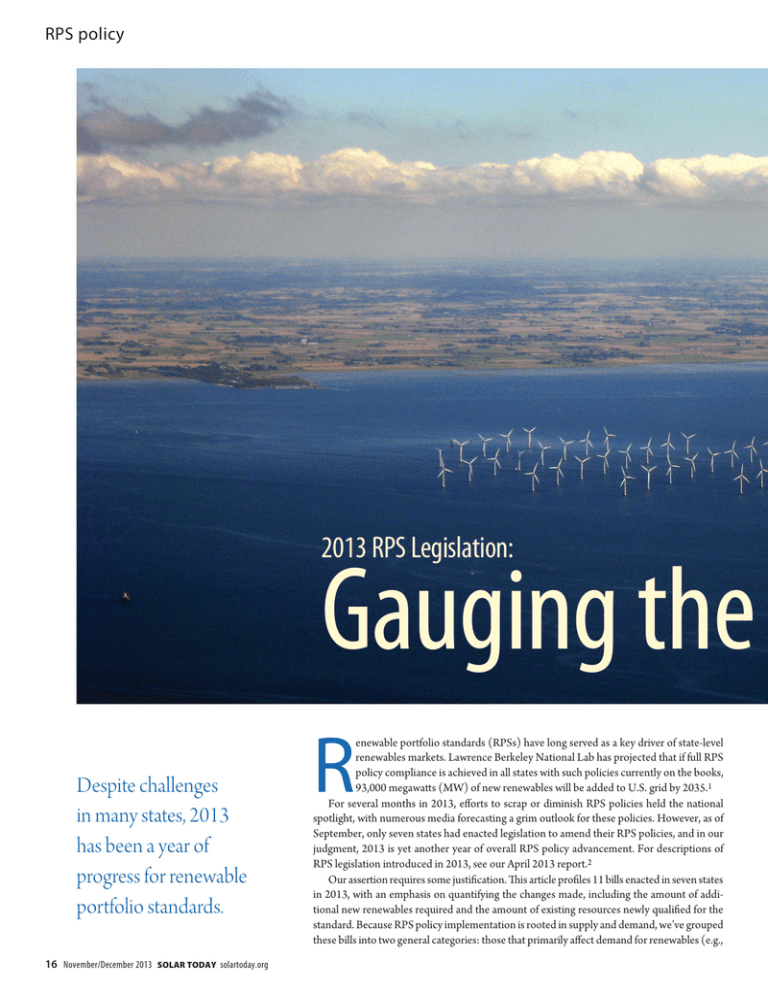
RPS policy
2013 RPS Legislation:
Gauging the
Despite challenges
in many states, 2013
has been a year of
progress for renewable
portfolio standards.
16 November/December 2013
SOLAR TODAY solartoday.org
R
enewable portfolio standards (RPSs) have long served as a key driver of state-level
renewables markets. Lawrence Berkeley National Lab has projected that if full RPS
policy compliance is achieved in all states with such policies currently on the books,
93,000 megawatts (MW) of new renewables will be added to U.S. grid by 2035.1
For several months in 2013, efforts to scrap or diminish RPS policies held the national
spotlight, with numerous media forecasting a grim outlook for these policies. However, as of
September, only seven states had enacted legislation to amend their RPS policies, and in our
judgment, 2013 is yet another year of overall RPS policy advancement. For descriptions of
RPS legislation introduced in 2013, see our April 2013 report.2
Our assertion requires some justification. This article profiles 11 bills enacted in seven states
in 2013, with an emphasis on quantifying the changes made, including the amount of additional new renewables required and the amount of existing resources newly qualified for the
standard. Because RPS policy implementation is rooted in supply and demand, we’ve grouped
these bills into two general categories: those that primarily affect demand for renewables (e.g.,
Copyright © 2013 by the American Solar Energy Society Inc. All rights reserved.
SOLAR TODAY
NOVEMBER/DECEMBER 2013
VOL. 27, NO. 7
®
By JUSTIN BARNES and
CHELSEA BARNES
Justin Barnes coordinates the Keyes, Fox &
Wiedman LLP regulatory-tracking service, which
provides clients with periodic reports and analysis
of pending energy regulations at the U.S. state level.
He earned his master’s in environmental policy at
the Michigan Technological University.
Impacts
SWEDISH WIND FARM BY TOMASZ SIENICKI
Chelsea Barnes coordinates the Keyes, Fox &
Wiedman LLP legislative-tracking service, which
provides clients with periodic reports and analysis of pending energy legislation at the U.S. state
level. She also researches and analyzes solar incentives for incorporation into financial models. She
received a master’s in environmental management
from Duke University.
Maryland’s H.B. 226, with a carve-out for offshore
wind power, could support up to 1.6 million
megawatt-hours (MWh) of new wind generation
in 2017 and beyond, equivalent to 450 to 500 MW.
However, PSC analysis of cost limitations suggests
a likely maximum of 725,000 MWh, equivalent to
roughly 210 MW of new offshore wind.
establishment of new targets, reductions in targets), and those that primarily affect supply (e.g.,
resource or renewable energy credit eligibility).
Demand-Side Changes
The most significant impacts of demand-side legislative changes in 2013 involve new requirements in Colorado, Maryland and Minnesota, as indicated in table 1 on page 18. The collective new benchmarks appear likely to eventually support more than 1,000 MW of additional
renewables, including more than 500 MW of additional solar. The actual figures will depend
on several factors, such as load growth, resource mix (as it influences capacity estimates), the
use of compliance multipliers and the triggering of cost caps. Moreover, these impacts will
not be wholly state-specific. For instance, the impact of Maryland’s offshore wind carve-out
1 http://www.cleanenergystates.org/assets/2012-Files/RPS/RPS-SummitDec2012Barbose.pdf
2 http://www.kfwlaw.com/wp-content/uploads/2013/09/RPS_Legislation_KFW_Apr2013_sm.pdf
Copyright © 2013 by the American Solar Energy Society Inc. All rights reserved.
solartoday.org SOLAR TODAY November/December 2013 17
RPS policy
ALEC’s efforts to repeal state RPS laws flopped in 2013. It’s now drafting two new model bills
for the 2014 legislative session that aim to diminish RPS policies.
TABLE 1
Bill
Demand-Side Changes to State RPS Policies in 2013
Changes to Law
Potential Impacts
CO S.B. 252 t & òFDUJWFMZSBJTFTUIF314GPSDPPQTGSPN
UPCZ
t &TUBCMJTIFTBEJTUSJCVUFEHFOFSBUJPO%(
DBSWFPVUPGGPSDPPQTXJUIPS
NPSFDVTUPNFSTBOEGPSTNBMMFSDP
PQTPGUIFDBSWFPVUNVTUDPNFGSPN
customer-sited systems.
t "MMPXTDPBMNJOFNFUIBOFBOEDFSUBJO
NVOJDJQBMTPMJEXBTUF.48
QZSPMZTJTUP
qualify for the RPS.
t &YQBOETDPTUDBQGSPNUPGPSDPPQT
t &MJNJOBUFTJOTUBUFSFTPVSDFQSFGFSFODFT
t "TFQBSBUFFYFDVUJWFPSEFSFTUBCMJTIFTBO
advisory committee that will evaluate the
FòFDUJWFOFTTBOEGFBTJCJMJUZPGUIFOFXMBX
Overall RPS: 1.3 million MWh of additional renewables generation
SFRVJSFECZJFBQQSPYJNBUFMZ.8BTTVNJOHBOBWFSBHF
DBQBDJUZGBDUPSPGGPSXJOE
*NQBDUPGDPBMNJOFNFUIBOFBOE
MSW pyrolysis uncertain.
DG: 150,000 MWh of DG generation required by 2020, including 75,000
.8IGSPNDVTUPNFSTJUFETZTUFNTJFBQQSPYJNBUFMZ.8GPS
MBSHFSDPPQTBOEBQQSPYJNBUFMZ.8GPSMBSHFSDPPQTBTTVNJOHBO
BWFSBHFDBQBDJUZGBDUPSPGGPSTPMBS
MD H.B. 226 t $ SFBUFTBOPòTIPSFXJOEDBSWFPVUPGVQUP
CZSFEVDJOHUIFSFRVJSFNFOUGPS
other Tier 1 resources by an equivalent amount.
t &TUBCMJTIFTWBSJPVTDPTUDPOUBJONFOU
measures and protocols for approval of
qualified resources.
Offshore Wind$PVMETVQQPSUVQUPNJMMJPO.8IPGOFXPòTIPSF
wind generation in 2017 and beyond, equivalent to 450-500 MW.
)PXFWFS14$BOBMZTJTPGDPTUMJNJUBUJPOTTVHHFTUTBMJLFMZNBYJNVNPG
.8IFRVJWBMFOUUPSPVHIMZ.8PGOFXPòTIPSFXJOE
Other Tier I Resources: Reduction in MWh requirement equivalent to
BOZPòTIPSFXJOEDPOUSJCVUJPO.
MN H.B. 729; t &TUBCMJTIFT17DBSWFPVUPGCZGPS
S.B. 1057
*06TPGXIJDIJTSFRVJSFEGSPNDVTUPNFS
sited systems up to 20 kW.
t &TUBCMJTIFTSFMBUFE17JODFOUJWFTJODMVEJOHB
general statewide performance-based incentive
1#*
GPSTZTUFNTVQUPL8BTFQBSBUFSFCBUF
for systems using Minnesota-made components
GPSTZTUFNTVQUPL8BOEB7BMVFPG4PMBS
5BSJò7045
t &YQMJDJUMZBTTJHOT3&$PXOFSTIJQUPUIFVUJMJUZGPS
UIF.JOOFTPUB.BEFJODFOUJWFBOEUIF7045CVU
not for net metering or the statewide PBI.
PV.8PGOFX17HFOFSBUJPOPGXIJDI.8XPVMECFSFRVJSFE
from systems up to 20 kW.
MT S.B. 164 t & YFNQUTGSPNUIF314VUJMJUJFTTFSWJOHPS
fewer customers.
Overall RPS&YFNQUT"WJTUBBOE#MBDL)JMMT1PXFSGSPNUIF314
reducing the amount of renewable generation needed under the
TUBOEBSECZBQQSPYJNBUFMZ.8IPVUPGBUPUBM
SFRVJSFNFOUPGBQQSPYJNBUFMZ.8IJO
MT S.B. 327 t & YFNQUTGSPNUIF314DPNQFUJUJWFTVQQMJFST
serving four or fewer customers.
Overall RPS&YFNQUT$POPDP1IJMJQTGSPNUIFTUBOEBSESFEVDJOH
the amount of renewable generation needed under the standard by
SPVHIMZ.8IPVUPGBUPUBMSFRVJSFNFOUPG.8I
JO
WA
H.B. 1222;
S.B. 5297
t $ SFBUFTBOBEEJUJPOBMBMUFSOBUJWFDPNQMJBODF
method for utilities that have purchased only
coal transition power since Dec. 7, 2006.
18 November/December 2013
Overall RPS: Potentially reduces the amount of renewables generation
required by giving Puget Sound Energy and any new purchasers of
$FOUSBMJB$PBMFOFSHZBOBMUFSOBUJWFDPNQMJBODFNFUIPEUIBU
does not involve additional purchases of renewables. The ultimate
impact is uncertain.
SOLAR TODAY solartoday.org
will depend on what can be achieved within the
associated ratepayer impact limitations, and
whatever is achieved will reduce demand for
other Tier I resources in the state, which affects
available supply on a regional level. Minnesota’s
new solar carve-out is unclear on whether existing and out-of-state resources qualify and how
some other programs authorized in the legislation will operate within the context of RPS (i.e.,
renewable energy credit, REC, ownership). The
outcomes, when determined, could have both
state and regional implications for solar development. Legislation enacted that had the effect
of reducing existing RPS policies was generally
minimal in impact (e.g., in Montana), although
the impact of Washington’s legislation is difficult
to predict.
Supply-Side Changes
Like demand-side RPS changes, supply-side
RPS changes often have regional rather than
state-specific impacts and in some cases involve
an amount of uncertainty. Connecticut’s RPS
bill is probably the best example of both interstate connectedness and uncertainty; each individual provision has implications for regional
supply and demand, and some important details
(e.g., the strategy for a migration away from
existing biomass and landfill gas dependence)
are undetermined. The same could be said for
RPS amendments enacted in Nevada, where
it is uncertain whether utilities will be able to
sell excess credits, and in Montana, where it is
unknown to what extent the RPS amendments
will stimulate hydropower expansions. Table 2
(facing page) outlines the changes and impacts
of supply-side legislation enacted in 2013.
None of the enacted supply-side bills seems
destined to have an immediate, significant or
detrimental impact on renewables as a whole.
On the contrary, the potential negative impacts
likely will be small (e.g., the qualification of treated wood as biomass in Montana), while other
changes have either generally positive implications, or represent accommodations that are not
necessarily unreasonable or detrimental in the
context of furthering renewables development.
For solar specifically, we believe that the impacts
are almost entirely positive, providing potential
financing support for grid-supply projects in
Copyright © 2013 by the American Solar Energy Society Inc. All rights reserved.
New England, and at least slightly better opportunities for solar growth in Nevada.
2013-2014 Legislative Outlook
for RPS Policies
Although most state legislatures have closed
up shop for 2013, a few RPS bills could see
action in the 10 state legislatures still in sesTABLE 2
sion. A total of six “weakening” bills are still
in play in Ohio, Wisconsin, Pennsylvania and
California; we consider Ohio’s RPS repeal bill
(S.B. 58) the most likely to see any real action.
Ten “strengthening” bills remain in committee in Pennsylvania, New York, New Jersey,
Michigan, Massachusetts and the District of
Columbia (D.C.); the D.C. bill (B20-0418) to
Supply-Side Changes to State RPS Policies in 2013
Bill
Changes to Law
Potential Impacts
CT S.B. 1138
t * ODSFBTFTTJ[FMJNJUPGTNBMMIZESPGSPN.8UP
.8GPS$MBTT*SFTPVSDFTBOESFNPWFTSJWFSøPX
impact limitation.
t (SBEVBMMZSFEVDFT3&$WBMVFTGPSCJPNBTTBOE
landfill gas.
t 1SPIJCJUT3&$EPVCMFDPVOUJOHGPS
out-of-state resources.
t 4FUTDPOEJUJPOTBOEMJNJUTGPSMBSHFIZESP
RVBMJöDBUJPOBTB$MBTT*SFTPVSDF
t &TUBCMJTIFTMPOHUFSNDPOUSBDUJOHQSPHSBNTGPS
OFXBOEFYJTUJOH$MBTT*SFTPVSDFTVQUPPG
SFUBJMMPBEFBDI
Small Hydropower2VBMJöFTBOFTUJNBUFE.8PGFYJTUJOHIZESPQPXFSJO/FX&OHMBOEBTB$MBTT*SFTPVSDF
Out-of State Resources: Disqualifies an estimated 21.6 MW
PGFYJTUJOHSFTPVSDFTJO/:BOEQSFWFOUTRVBMJöDBUJPOPGNPSF
UIBO.8PGSFTPVSDFTJO75
Biomass/Landfill Gas: Reduction strategy hasn’t been
EFUFSNJOFECVUDPVMEBòFDUBQQSPYJNBUFMZ.8PGFYJTUJOHGBDJMJUJFTDVSSFOUMZRVBMJöFEBT$MBTT*SFTPVSDFT
New Class I Contracting1FSB+VMZ3'1.8
.8PGXJOEDBQBDJUZ
VOEFSMPOHUFSNFMFDUSJDJUZBOEPS3&$
contracts, limited to facilities 20 MW or larger in aggregate.
MT S.B. 325
t 3 FWJTFTUIFEFöOJUJPOPGFMJHJCMFCJPNBTTUP
allow chemically-treated wood to qualify as a
renewable resource.
Non-Biomass Renewables$PVMEFYQFSJFODFSFEVDFE
opportunities under the standard, but the actual impact is
VOLOPXO$VSSFOUMZOPVUJMJUJFTBSFVTJOHCJPNBTTUPDPNQMZ
XJUIUIF314BOEOPCJPNBTTGBDJMJUJFTFYJTUJO.5
MT S.B. 45
t " MMPXTJODSFNFOUBMHFOFSBUJPOGSPNFYQBOTJPOT
PGFYJTUJOHIZESPQPXFSGBDJMJUJFTUIBUDPNNFODF
construction after Oct. 1, 2013, to qualify for
the standard.
Non-Hydro Resources$PVMEFYQFSJFODFSFEVDFEPQQPStunities under the standard, but the impact is unknown.
Montana has more than 2,700 MW of hydro capacity; a large
CBTFFYJTUTGPSQPUFOUJBMFYQBOTJPOTBMUIPVHINVDIPGJUJT
federally owned.
NV S.B. 252
t & MJNJOBUFTUIFDVSSFOUNVMUJQMJFSGPS17GPS
facilities constructed after 2015.
t -JNJUTFOFSHZFóDJFODZUPPGTUBOEBSEJO
BOEGPSGPSBOE
none thereafter.
t &TUBCMJTIFTTFQBSBUFQSPUPDPMTGPSVUJMJUJFTUPTFMM
FYDFTT3&$TXIFSFUIFTVSQMVTFYDFFETBOE
of the subsequent year’s compliance requirement.
Energy-Efficiency Phase-Out:3FTVMUTJOBQQSPYJNBUFMZ
8 million to 9.5 million MWh of additional renewables
HFOFSBUJPOSFRVJSFEUISPVHI$PVQMFEXJUIDPNQMJance requirement increases, could impact solar by forcing
utilities to use solar credits to meet the general renewables
requirement.
Excess Credit Sales: If credit sales take place, they will
likely be most impactful for the solar tier, which has a larger
FYQFDUFETVSQMVTJOSFMBUJPOUPDPNQMJBODFSFRVJSFNFOUT
than the general renewables tier. Sales are unlikely to impact
VUJMJUZVTFPGFóDJFODZGPSDPNQMJBODFCFDBVTFFYDFTTDSFEJUT
NBZCFEJóDVMUUPTFMMBOEVUJMJUJFTXJMMVOMJLFMZOFFEUP
VUJMJ[FQBTUTVSQMVTFTVOEFSUIFSFEVDFEBMMPXBODFTGPSFóciency under the standard.
WA S.B. 5400 t " MMPXTVUJMJUJFTUIBUTFSWFSFUBJMDVTUPNFSTJOPUIFS
states to use owned or contracted generation from
SFOFXBCMFTGBDJMJUJFTFYDFQUIZESPQPXFS
JOUIPTF
states to meet the WA RPS.
Overall RPS:&òFDUJWFMZJODSFBTFTUIFSFOFXBCMFTTVQQMZ
BWBJMBCMFUP1BDJö$PSQ*OQSBDUJDFJUXJMMBMMPX.8PG
1BDJö$PSQTXJOESFTPVSDFTJOFBTUFSO8ZPNJOHUPRVBMJGZGPS
the RPS. Previously, these resources would have qualified only
if the electricity was delivered into WA on a real-time basis.
Copyright © 2013 by the American Solar Energy Society Inc. All rights reserved.
eliminate black liquor and other forms of biomass as eligible resources is the only such bill
under active consideration.
Looking forward to 2014, it is almost certain
that legislators will continue to debate and tinker
with RPS policies. However, activity might be
muted because in many states, even-year legislative sessions are less active than odd-year sessions, and some states (such as Montana and
Texas) are not scheduled to convene at all in
2014. In addition, it is expected that many of the
unresolved issues in 2013 will be carried forward
for discussion in 2014, especially in the 25 states
(and D.C.) that carry over legislation from oddyear sessions to even-year sessions.
The American Legislative Exchange Council (ALEC), which has been credited with (and
discredited for) stirring up several RPS repeal
efforts in 2013, has been busy drafting two
new model bills for the 2014 legislative session that aim to diminish state RPS policies.
Although ALEC’s efforts to repeal state RPS
laws flopped in 2013, it appears that the organization is converting its strategy for 2014 to
an approach that sounds (at least superficially)
less “anti-renewables.” Together, the two new
model bills — the Market-Power Renewables
Act and Renewable Energy Credit Act — would
phase out RPS requirements, replace them with
voluntary markets, expand the types of energy
that would qualify as renewable, remove caps
on the amount of RECs that may be used for
compliance, and allow bulk purchases of RECs
to be used for compliance in advance of future
requirements. Thus, the new model bills amount
to a change in branding and design, but with the
same underlying intent.
It is very likely that further legislative efforts
to repeal, freeze or otherwise dismantle RPS
policies will continue in 2014, and that at least
some of these efforts will contain provisions
inspired by ALEC’s model bills. For instance,
we consider it very likely that bills seeking to
expand resource definitions to include large or
existing hydropower will crop up in states such
as Maine and others that saw similar efforts during 2013. However, while predictions of legislative outcomes are always speculative, we do
not see any compelling reasons suggesting that
2014 outcomes will be much different than 2013
outcomes. We expect states to continue making measured revisions that generally portend
positive impacts on renewables development. ST
solartoday.org SOLAR TODAY November/December 2013 19




